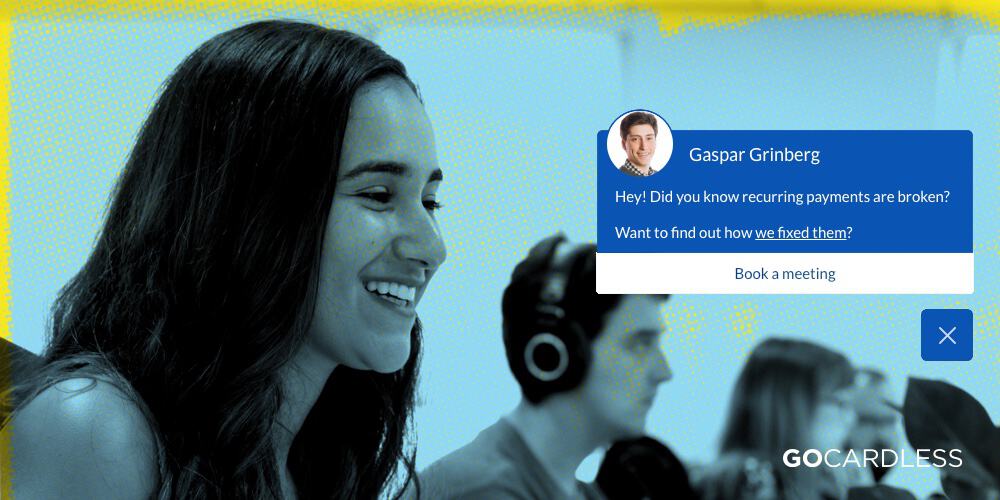
Hi everyone, my name is Rupert, and I lead growth marketing at GoCardless – the leading global fintech for recurring payments, currently processing $10B a year.
When I joined GoCardless in 2017, we weren’t utilizing the company’s website as much as we should’ve been. Sure, we have a great website and strong SEO, but we also noticed we were not converting 97% of our traffic. So we decided to look into alternatives to increase conversions and start conversations earlier in the buying cycle.
I first learned about Drift from this blog post about how Segment was using Drift to drive growth and from listening to the Seeking Wisdom podcast. We liked what we heard about conversational marketing, so we decided to take the plunge.
Getting Started With Conversational Marketing
As a business, we have three “channels” to help our website visitors get started on our platform. These are filling out a contact-sales form, calling our phone-line, and signing up directly. By implementing Drift, we were adding a fourth conversion option for our site visitors.
When we chose Drift, we decided to run an A/B test on three pages on our site:
- Homepage (Broad level of intent – customers can be people looking for support or can be people ready to buy)
- How It Works pages (Middle-level intent)
- Pricing Page (High-intent)
We needed to see if Drift would cannibalize our other channels and if it was worth the investment.
To run this AB test for conversational marketing, we had to “hard-code” Drift on each of those three pages allowing us to show the chatbot only to our variation groups.
Once we added a bot to these three pages, we made a hypothesis.
Hypothesis: Drift will be a source of net new leads and business. Because otherwise, the 97% of traffic that was not converting would have converted already.
What the A/B test found: Drift not only uncovered a completely net-new source of leads, opportunities, and business – but it also complemented our other channels.
Meaning, our form submits increased once we added Drift ?
Our sample size for this test was 40k+ website visitors, so statistical significance was reached.
That’s when we decided to fully roll out Drift across our entire site.
Recommending the Best Solution for Our Site Visitors
GoCardless has the ability to serve any size of business that takes recurring payments. Be it a global SaaS company or a 1-person accounting firm. This means the revenue delta between our potential customers is extremely vast.
Before we implemented conversational marketing, we didn’t have a great way to quickly qualify our site visitors before they get to a sales rep.
Sure, we could ask information on our contact sales form, or directly have one of our sales reps ask on a phone call, but we needed a more efficient strategy.
So the way we solved this was by simply pushing small businesses to sign up for free and sending larger businesses to our sales team.
After a lot of testing with our qualifying question (number of employees, number of transactions, number of currencies, etc.), we learned this was our best one?
“Since we’re a payment platform, which annual revenue range would you like us to process for you?”
With that question in our bot, we can automatically push our larger prospects to our sales team for live chat (during work hours) or book a meeting (out of work hours) and send the smaller prospects to sign up immediately.
Now, for the second phase of our conversational marketing strategy, we’re working on creating a more structured prioritization of our playbooks. The pyramid structure.
The more targeted and niche playbooks will be of the highest priority and the broader, catchall playbooks will be of lower-priority.
Here’s an overview of our highest priority playbooks?
- ABM Playbooks: Provide highly relevant messages based on the value props and business cases for each strategic account.
- Partner Playbooks: Highlight a direct integration we have with a key partner (like Zuora) once we know which website visitors use that specific partner.
- Competitor Playbooks: Send a battle card message to those who use a competitor (e.g. Did you know our payment failure rate is 90% lower than competitor X?)
To do this we use Clearbit to target based on the firmographic information. Then below that are other playbooks that target wider audiences, such as specific industries and company revenue.
If site visitors don’t fall into any of our firmographic based playbooks, they’ll see the playbooks we first implemented (Home page, How It Works page, Pricing page, etc.).
The playbooks are also localized by country. Currently, the conversational marketing strategy is live in the UK, France, Germany, and Spain.
Results
The results so far? After running the Homepage, How It Works, and Pricing playbooks for just over a month, we were able to collect statistically significant information. With a sample size of over 40k+ site visitors, we found that our hypothesis was true – Drift had become a major source of net new leads and business.
In fact, we’ve found that Drift provides incremental 20% net new opportunity growth globally.
I’m glad we took the plunge with conversational marketing. Because turned out to be a huge win for our company.
Learn other ways to reduce friction for your buyers and create an unforgettable experience here.
My name’s Rupert, growth marketer at GoCardless. Ever since co-founding the first daily-fantasy football app in the UK, I’ve been in growth and digital marketing roles. Specialising in large-scale, revenue-generating projects like ABM, intent and conversational marketing.
Editor’s Note: This is a guest post from Drift customer GoCardless. Interested in contributing content to the Drift blog? Email Elizabeth Hilfrank at ehilfrank@drift.com



